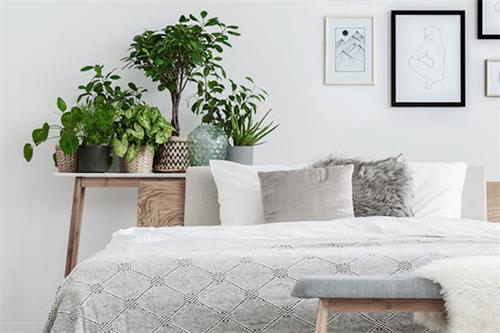Choosing the Right Plants for Every Room

Transforming your living space into a verdant haven isn’t just about aesthetic appeal—it’s a lifestyle choice that nurtures well-being, improves air quality, and brings a touch of nature indoors. By thoughtfully selecting plants suited to the unique light, humidity, and functional needs of each room, you can create thriving micro-ecosystems throughout your home. From air-purifying palms in the living room to low-maintenance succulents on your desk, this guide will help you curate an indoor garden that enhances your daily life and fosters a deeper connection to nature.
The Living Room: Statement Greenery for Gathering Spaces
The social center of your house is your living room, where you can host guests, unwind, and create memories. Here, you may add bigger, more striking plants that act as focal points and living sculptures:
● Fiddle Leaf Fig (Ficus lyrata): With its broad, violin-shaped leaves, this plant creates instant visual impact. It prefers steady moisture and grows best in bright, indirect light.
● Bird of Paradise (Strelitzia reginae): For a tropical flair, this plant’s large, upright leaves evoke a resort-style ambiance. It requires bright light and regular watering but rewards you with spectacular growth.
● Monstera Deliciosa: Famous for its perforated leaves, the Monstera adapts well to medium light and moderate humidity, making it forgiving for beginners.
Arrange these specimens near windows or beside seating areas to draw the eye and anchor your décor. A well-placed floor pot or stylish plant stand elevates the greenery and integrates it seamlessly into your living room design.
The Bedroom: Calming Companions for Restful Nights
Bedrooms benefit from plants that promote relaxation, improve air quality, and endure lower light levels:
● Snake Plant (Sansevieria trifasciata): Virtually indestructible, this plant converts CO₂ to oxygen at night, enhancing air purity while requiring minimal care.
● Peace Lily (Spathiphyllum): Known for its delicate white blooms, the peace lily thrives in low light and high humidity, making it ideal for bedside tables or dressers.
● Lavender (Lavandula angustifolia): Though typically an outdoor herb, potted lavender on a sunny windowsill can fill your room with soothing fragrance that supports sleep.
For optimal benefit, place these plants on nightstands or dressers where they can cleanse the air and release calming scents close to you as you drift off.
The Kitchen: Hardy Herbs and Air Purifiers by the Stove
In the kitchen, combine functional herbs with plants that cope well with temperature fluctuations and cooking-induced humidity:
● Herb Garden Trio: Rosemary, mint, and basil in a windowsill container. With frequent watering and bright light, they thrive and offer fresh ingredients for cooking.
● Spider Plant (Chlorophytum comosum): Exceptionally tolerant of varied conditions and excellent at removing kitchen fumes.
● Pothos (Epipremnum aureum): Its trailing vines soften corners and can thrive under artificial lighting if sunlight is scarce.
Keep herbs in small pots near the sink or stove for easy access. Larger air-purifying plants can occupy open shelving or hang in macramé holders to save counter space.
Crafting an indoor garden tailored to each room transforms your home into a sanctuary of health, beauty, and calm. By choosing plants that suit the specific environmental conditions and functional needs of your spaces—whether it’s statement greenery in the living room, air-cleansing allies in the bedroom, or aromatic herbs in the kitchen—you cultivate not just a decorating trend, but a lifestyle rooted in well-being and environmental connection.



